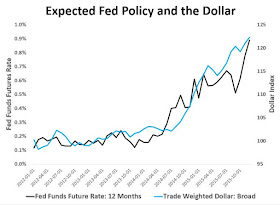Whether or not a recession actually occurs, one thing is certain. The Fed in its current form is not well equipped to handle another downturn. The Fed’s inability over the past seven years to create a strong recovery from the last recession speaks to this weakness. The Fed tried everything from pushing interest rates to zero percent to buying up trillions of dollars of government bonds and yet it was still not able to generate the spending needed to get the economy back to full health.[...]
The real reason for this failure is the Fed’s firm commitment to low inflation. Like a governor placed on a truck’s engine to control its speed, a commitment to low inflation helps prevent the economy from growing too fast. Normally, this is a good thing. But sometimes it can backfire. A truck driver may need to temporarily go faster to make up for lost time after being stuck in traffic. Similarly, an economy may need to temporarily speed up to get back to its full potential after a recession. Neither can happen with a rigid adherence to the speed limit.
I go on to argue that a nominal GDP level target (NGDPLT) is the answer, but with a twist: make it more credible by having a treasury backstop. The beauty of this arrangement is that since it throws the entire weight of the consolidated government balance sheet behind the NGDPLT, it increases the target's credibility and means the treasury backstop will rarely, if ever, have to be used.
Nick Rowe likes to say that central banking is like Chuck Norris walking into a room and telling everyone to get out. They fear Chuck Norris and so will leave the room without him ever having to throw a punch. Chuck Norris is using expectation management just like a central bank does to shape behavior. Recall the market reaction to Mario Draghi saying "whatever it takes" in 2012 or Ben Bernanke doing his "taper talk" in 2013. These are examples of Chuck Norris the central banker at work.
Now imagine Chuck Norris the central banker comes to the room with his friend Jean-Claude Van Damme the treasury secretary. Chuck Norris still walks into the room alone and tells everyone to get out. This time, though, he mentions that his buddy Jean-Claude is waiting outside and has his back. Now the folks inside the room go from being fearful to truly terrified and flee out of the room. Jean Claude never has to go into the room. Just knowing he is outside is enough for the people in the room. That is the idea of an explicit treasury backstop to the Fed's NGDPLT. It will add credibility, but probably never have to be used.
P.S. Scott Sumner was on Reddit yesterday answering questions. One question that was asked is where are the models for Market Monetarism. There are no models for Market Monetarism. There is, however, serious model-based work being done on NGDP targeting. I thought I would list some of the recent ones below, including my work with Josh Hendrickson:
(2) James Bullard: Optimal Policy at the Zero Lower Bound
(3) Eric Sims et al.: On the Desirability of Nominal GDP Targeting
(4) Evan Koenig: Monetary Policy, Financial Stability, and the Distribution of Risk
(5) Michael Belongia and Peter Ireland: A "Working" Solution to the Problem of NGDP Targeting
(6) Josh Hendrickson & David Beckworth: Nominal GDP Targeting versus the Taylor Rule on an Even Playing Field
(7) Josh Hencrickson & David Beckworth: The Supply of Transaction Assets, Nominal Income, and Monetary Policy Transmission





















